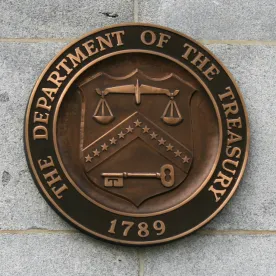Continuing the recent string of actions across the Biden administration in response to the July 2021 Executive Order on “Promoting Competition in the American Economy,” on March 7, 2022, the US Treasury Department (Treasury) released a report titled “The State of Labor Market Competition,” and on March 10, 2022, the US Departments of Justice (DOJ) and Labor (DOL) announced a Memorandum of Understanding (MOU) to strengthen and coordinate enforcement efforts in labor markets. These developments highlight the administration’s continuing focus on anticompetitive conduct in the labor markets at both the local and national levels and warrant careful attention by employers of all sizes and in all industries.
Treasury Report In Depth
-
Treasury’s report sets out to “summarize the prevalence and impact of uncompetitive firm behavior in labor markets.”
-
It focuses on both inter-employer conduct—such as the sharing of wage information, entering into no-poach agreements and outright conspiracies to fix wages—and employer-employee conduct—like forcing workers to sign non-compete agreements, mandatory arbitration agreements and class action waivers, misclassification of employees as independent contractors and opacity surrounding employees’ compensation rates—as being potentially anticompetitive and contributing to the imbalance of power between employers and employees in labor markets.
-
The structures of various labor markets, including overall low rates of unionization, “fissuring” of workplaces as a wide variety of job functions (e.g., janitorial or food services) are outsourced from in-house employees to external contractors, and occupational licensing requirements imposed by federal, state, and/or local governments, are highlighted as having overall negative effects on the competitiveness of various labor markets.
-
The report estimates that employers’ market power is responsible for approximately 20% lower wages compared to a fully competitive labor market, and notes that the harms that flow from a lack of labor market competition disproportionately impact lower-income occupations, women and people of color.
-
The report concludes by emphasizing that adverse effects on workers as a result of limited competition in labor markets have broader effects on the labor markets, the firms that participate in them and the economy as a whole.
-
Finally, the report specifically examines the labor markets in the healthcare, agricultural and minor-league baseball industries, and it outlines the Biden administration’s efforts to increase competition and deter and punish anticompetitive conduct in labor markets across the country.
The Memorandum of Understanding (MOU)
-
The DOJ and DOL’s MOU likewise emphasizes the shared “interest in protecting workers who have been harmed or may be at risk of being harmed as a result of anticompetitive conduct,” as Assistant Attorney General Jonathan Kanter noted in the joint press release announcing the MOU, “[p]rotecting the right of workers to earn a fair wage is core to the work of both our agencies, and it will continue to receive extraordinary vigilance from the Antitrust Division.”
-
The MOU states the DOJ’s and DOL’s intent to “share enforcement information, collaborate on new policies, and ensure that workers are protected from collusion and unlawful employer behavior.”
Key Takeaways
The Treasury report focuses on several ways in which employers’ market power in the employment market is hypothesized to produce negative impacts on labor market participants, including:
-
Information sharing and agreements between employers;
-
Restrictive employment policies such as non-competes and arbitration agreements; and
-
Misclassification of employees as independent contractors.
With these as the motivating forces, employers should expect there will likely be greater numbers of enforcement actions brought to challenge these practices in the future.
Information Sharing and Agreements Between Employers
While information sharing or inter-employer agreements can have legitimate, pro-competitive purposes, employers—especially large employers and employers of highly-skilled or specialized workforces—should expect that these types of arrangements will receive increased scrutiny going forward.
These practices can take various forms, ranging from participation in trade association or industry surveys on employee wages, benefits or conditions of employment to no-poach agreements or, in the extreme, agreements between different employers to set the wages to be paid for different categories of employees.
Restrictive Conditions of Employment
There can likewise be valid reasons for an employer to want to protect trade secrets, intellectual property, customer lists and the like through the use of non-disclosure, non-compete or other restrictive covenants ancillary to an employment agreement. However, the potential for these types of agreements to have chilling effects on employee mobility is also likely to result in increased scrutiny from federal regulators.
The likelihood of government investigations and enforcement actions is higher in connection with less-specialized employment, where a connection to a legitimate interest in protecting the employer’s intellectual property grows more attenuated, and where the restrictive conditions are less narrowly-tailored to protecting the procompetitive interests of the employer, such as with non-compete clauses that are potentially unlimited in time or geography.
It is also likely that mandatory arbitration and class action waiver clauses will face heightened scrutiny in the future, reflecting a growing hostility to those types of clauses in the employment context.
Misclassification of Employees
The practice of erroneously classifying employees as independent contractors, called out in the Treasury report as a practice by which employers offload liability for tax and benefit costs onto the misclassified employees, is another area that is likely to receive increased scrutiny by regulators, especially in light of the MOU coordinating the enforcement efforts of DOJ and DOL.
What This Means
The marked shift in the Biden administration’s attitude towards the labor market as rife with anticompetitive conduct is evidenced by its willingness to endorse economic literature that supports regulation of employers’ practices in the labor markets. As a result, employers should anticipate increased scrutiny on their employment practices in the years to come.
-
Employers can anticipate greater regulatory scrutiny even where employment practices had not raised red flags for regulators in the past, where employers are not “large” relative to other employers in the labor market, and where labor markets are perceived to be highly competitive for the employers actually participating in the day-to-day hiring process.
-
Employers should be especially wary of sharing information or entering into agreements with other competing employers, as these types of practices can lead to costly and time-consuming government investigations, not to mention the potential for follow-on private litigation.
Employers can manage the business risks posed by this increased emphasis on competition in the labor markets, in consultation with skilled antitrust and labor counsel, by:
-
Implementing robust compliance programs that include training for HR staff, company executives and other employees with roles that could involve interaction with competitors, to ensure that they are educated on the proper scope and limitations of conduct when it comes to employee recruitment and competitor interactions;
-
Engaging in periodic reevaluations of their labor and employment agreements, practices and policies to ensure that any particularly risky policies, such as restrictive covenants in employment agreements, are narrowly-tailored to protect the employer’s legitimate interests while not being overbroad so as to invite regulatory scrutiny or litigation; and
-
Ensuring that the company’s approach to classifying workers as either employees or independent contractors is in line with the applicable legal standards.





 />i
/>i

